Primary prevention of coronary heart disease (CHD) involves proactively addressing modifiable risk factors before the onset of clinical symptoms. This preventative approach significantly reduces the incidence of myocardial infarction, sudden cardiac death, and other cardiovascular complications. We emphasize the implementation of evidence-based strategies through lifestyle modification, pharmacologic interventions, and targeted screenings.

Epidemiology and Public Health Relevance
Coronary heart disease remains the leading cause of mortality worldwide. Despite significant advances in treatment, prevention remains the most cost-effective and impactful method of reducing the global cardiovascular burden. Primary prevention targets individuals with no prior cardiovascular events but who possess risk factors that elevate their probability of future disease.
Identifying Risk Factors for Coronary Heart Disease
Modifiable Risk Factors
- Hypertension
- Dyslipidemia
- Diabetes mellitus
- Tobacco use
- Obesity
- Sedentary lifestyle
- Unhealthy diet
- Excessive alcohol intake
- Psychosocial stress
Non-Modifiable Risk Factors
- Age >45 years in men and >55 years in women
- Family history of premature CHD
- Male gender
- Genetic predisposition
Risk Assessment Tools for Early Detection
ASCVD Risk Estimator
Utilizing the ASCVD (Atherosclerotic Cardiovascular Disease) risk calculator provides a 10-year risk projection based on factors such as age, lipid profile, blood pressure, and smoking status. This tool aids clinicians in stratifying patients and tailoring preventive strategies accordingly.
Coronary Artery Calcium (CAC) Scoring
For individuals with intermediate risk, CAC scoring via CT scan offers additional predictive power, identifying subclinical atherosclerosis even when traditional markers are inconclusive.
Lifestyle Interventions for Risk Reduction
1. Dietary Modifications
- Emphasize the Mediterranean diet: rich in fruits, vegetables, legumes, nuts, whole grains, olive oil, and fish.
- Limit intake of saturated fats, trans fats, refined sugars, and sodium.
- Encourage plant-based diets when appropriate for added cardiovascular benefit.
2. Physical Activity
- Engage in moderate-intensity aerobic exercise (e.g., brisk walking) for at least 150 minutes per week or 75 minutes of vigorous activity.
- Include resistance training twice weekly to improve metabolic health.
3. Smoking Cessation
- Eliminate tobacco use through behavioral counseling, nicotine replacement therapy, and pharmacological support (e.g., varenicline, bupropion).
4. Weight Management
- Aim for a body mass index (BMI) between 18.5–24.9 kg/m².
- Combine caloric restriction, increased physical activity, and behavioral therapy for sustained results.
Pharmacologic Therapy in Primary Prevention
Statin Therapy
Statins are indicated in:
- Adults aged 40–75 with LDL-C ≥70 mg/dL and ASCVD risk ≥7.5%
- Diabetics aged 40–75
- Individuals with genetic hyperlipidemia
Statins effectively lower LDL cholesterol and reduce CHD risk by up to 30–40%.
Antihypertensive Agents
Blood pressure control targets:
- <130/80 mmHg for individuals with increased cardiovascular risk First-line therapies include ACE inhibitors, ARBs, calcium channel blockers, and thiazide diuretics.
Diabetes Management
- Maintain HbA1c <7% to reduce vascular complications.
- Employ SGLT2 inhibitors or GLP-1 receptor agonists for additional cardiovascular benefit in high-risk patients.
Antiplatelet Therapy
Routine aspirin use is no longer recommended in low-risk individuals due to bleeding risk. It may be considered for select high-risk patients after individualized evaluation.
Role of Psychosocial and Behavioral Factors
Stress Management
Chronic stress, anxiety, and depression increase cardiovascular risk. Interventions include:
- Cognitive-behavioral therapy
- Mindfulness-based stress reduction
- Adequate sleep hygiene
Social Determinants of Health
Socioeconomic status, access to care, and education level influence adherence and outcomes. Community health initiatives and policy-level interventions are vital for equitable prevention.
Guidelines and Recommendations
- American College of Cardiology (ACC) and American Heart Association (AHA) guidelines provide standardized protocols.
- USPSTF recommendations support evidence-based screenings for hypertension, hyperlipidemia, and diabetes.
- European Society of Cardiology (ESC) emphasizes global cardiovascular risk assessment and multidisciplinary prevention programs.
Future Directions in CHD Prevention
Emerging areas include:
- Precision medicine based on genetic and biomarker profiling
- Digital health tools for remote monitoring and engagement
- Artificial intelligence for predictive analytics and personalized recommendations
Primary prevention of coronary heart disease necessitates a comprehensive, individualized approach integrating lifestyle changes, pharmacologic management, and psychosocial support. By addressing risk factors early and consistently, we can significantly reduce the burden of cardiovascular disease, improve life expectancy, and enhance quality of life across populations.

